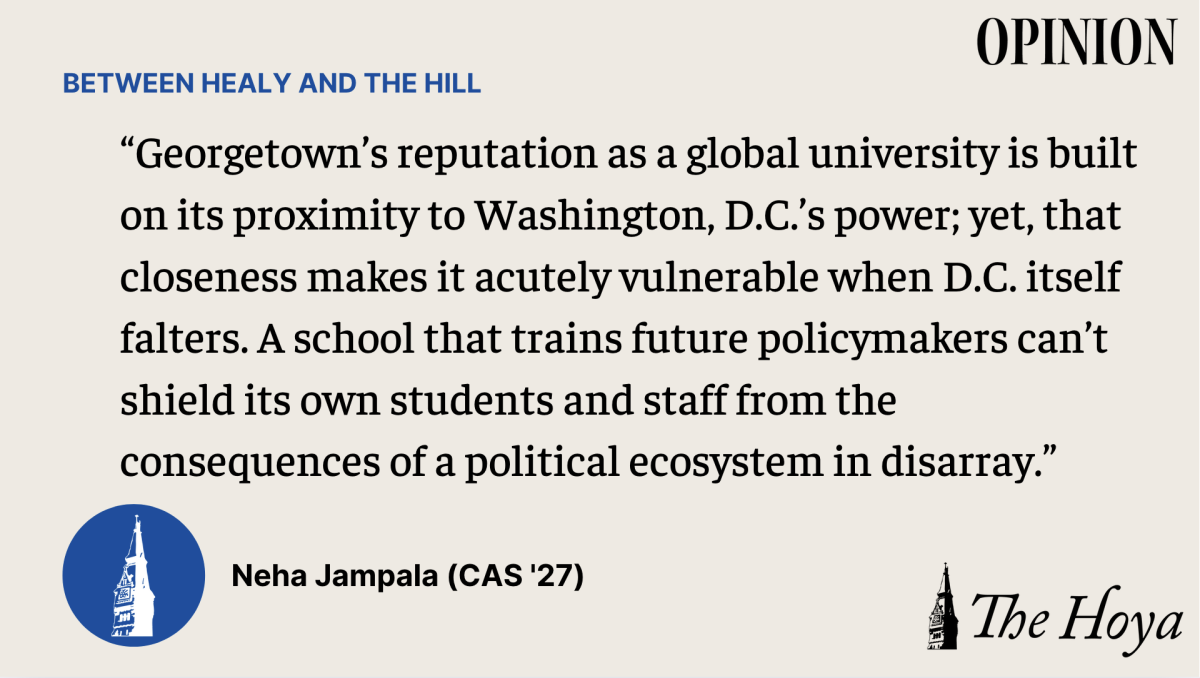
A federal shutdown could cost Georgetown University $462 million in research grants and financial aid. For a university that has built its identity on being global and inclusive, this loss of capital is not just a budget or accounting problem; it’s a test of how well the university can actually achieve its mission when federal dollars disappear.
Of Georgetown’s $1.8 billion operating budget, roughly 26% comes from federal sources: research grants, Pell Grants and work-study funds. When the government upends existing funding and policy structures, its support for institutions like Georgetown becomes precarious. Since President Donald Trump’s inauguration in January, the university has responded with a hiring freeze, a pause on merit raises for select employees and a plea for departments to “increase revenues from auxiliary services.”
In practice, this seems like the university wants to find means of revenue while waiting for Congress to function. Since the government shutdown began Oct. 1 and further entrenched concerns of funding and support stability, Georgetown has introduced temporary relief measures for affected community members; however, many still face uncertainty about longer-term support.
Interim Provost Soyica Diggs Colbert and other university leaders announced Oct. 20 a temporary grace period for students affected by furloughs, delayed federal pay or paused U.S. Department of Defense education benefits. The measure exempts students from late fees and registration holds but offers no retroactive forgiveness and requires proof of federal employment status. It provides breathing room, not security. For low-income and international students, that distinction matters. Georgetown must use its $3.6 billion endowment and Capitol Hill proximity to create emergency funding for affected students, advocate for stable federal education support, and protect workers from bearing the cost of political dysfunction — proving whether its globally minded mission can survive without federal crutches.
Pell Grant recipients are recalculating whether they can afford next semester, while work-study hours hang in the balance. International students, already navigating visa backlogs and surveillance, face renewed anxiety about whether they’ll even be allowed back after winter break as embassy staffing cuts and slower visa processing times threaten the foundation of Georgetown’s international community.
These pressures expose a deeper irony. Georgetown’s reputation as a global university is built on its proximity to Washington, D.C.’s power; yet, that closeness makes it acutely vulnerable when D.C. itself falters. A school that trains future policymakers can’t shield its own students and staff from the consequences of a political ecosystem in disarray.
Therefore, when the District shuts down, the global university model — reliant on visas, grants and student aid — collapses into a shell of purported values and promises.
The deeper issue is not just one shutdown. It lies in how dependent Georgetown’s values are on a system that treats education funding as a bargaining chip. The university’s reliance on the federal government has created a paradox: its institutional commitment to global service and inclusion is sustained by policies and budgets that can evaporate in a week.
As detailed in Colbert’s email, Georgetown’s recent grace period is a start, but it doesn’t resolve the deeper contradiction between the university’s mission and its dependence on federal funding. Real service to others requires sustained investment, not temporary exemptions tied to a federal shutdown form.
Georgetown has the potential to do better.
And it should use its prime location to advocate on Capitol Hill for stable federal education funding. Georgetown holds approximately $3.6 billion in endowed assets; dedicating even 2-3% could generate between $70 million and $108 million to cover federal aid gaps during shutdowns. This would ensure Pell Grant and work-study recipients do not have to choose between staying enrolled and paying rent when Congress fails to pass a budget.
Georgetown also needs to provide comprehensive legal and logistical support for international students navigating an increasingly hostile visa system. This means funding immigration attorneys, creating emergency response protocols for students stranded abroad during visa processing delays and establishing hardship grants for students who incur unexpected costs due to federal policy changes. Other universities, like New York University and the University of Michigan, have already created similar support structures, and Georgetown can follow suit.
Most importantly, Georgetown has proximity to power; it should take advantage of it. That means university leadership meeting regularly with lawmakers on education committees, testifying at budget hearings and joining coalitions of universities lobbying for stable federal funding for higher education.
Finally, Georgetown must reject the reflex to make its lowest-paid workers bear the cost of political gridlock. Freezing merit raises for employees earning over $50,000, which includes many administrative staff, librarians and junior faculty, sends a clear message about whose financial security matters. Instead, the university should commit to maintaining salaries and benefits for all employees during federal funding uncertainties, drawing on reserves if necessary.
The federal government may have shut down, but Georgetown does not have to. The university can still choose whether to mirror D.C.’s dysfunction or to model something better: stability, fairness and genuine care for the community that makes its mission possible. The question is whether Georgetown’s leaders have the courage to put the institution’s money where its mission statement is.
Neha Jampala is a junior in the College of Arts & Sciences. This is the second installment of her column “Between Healy and the Hill.”